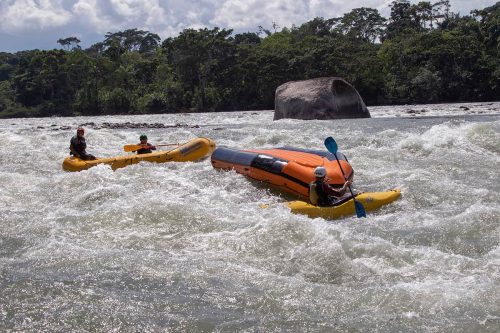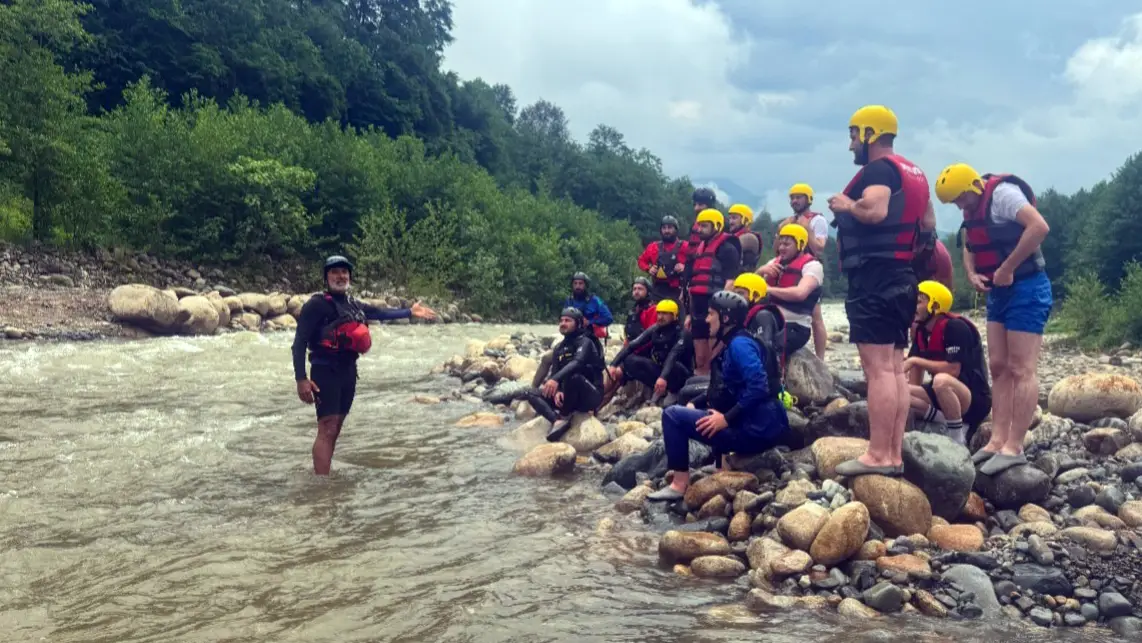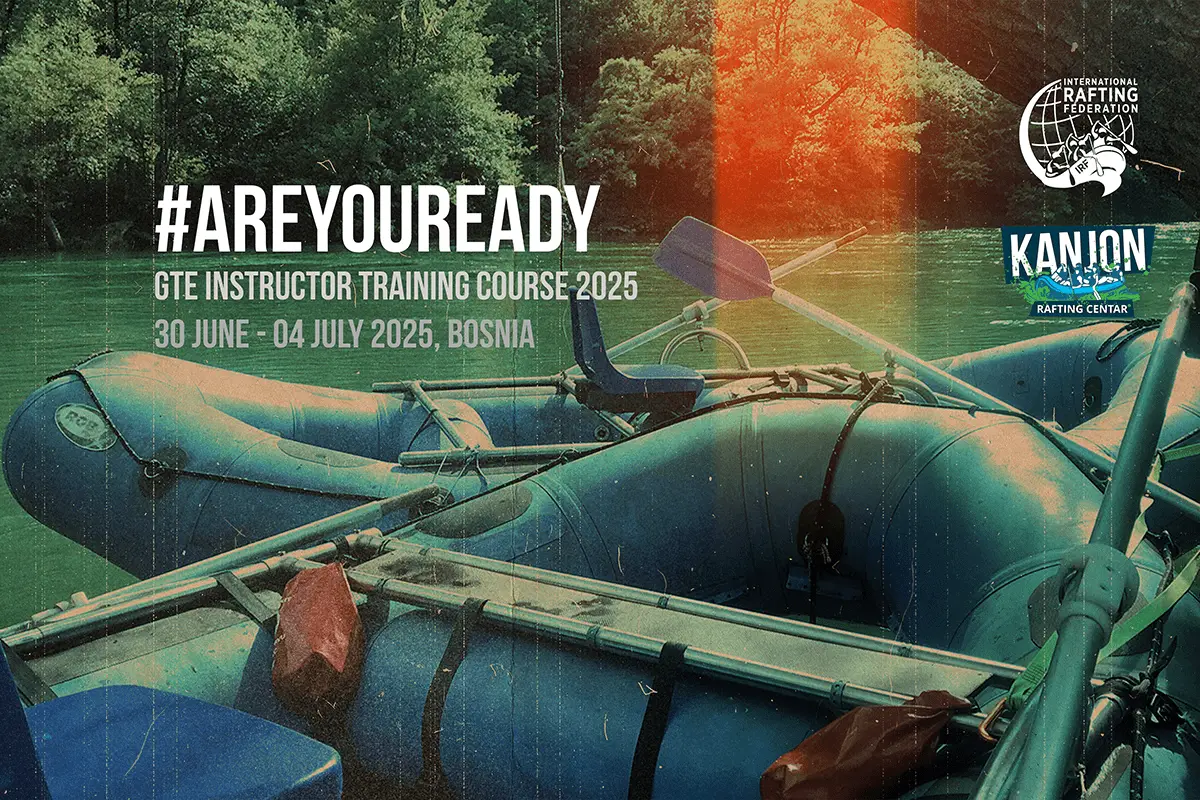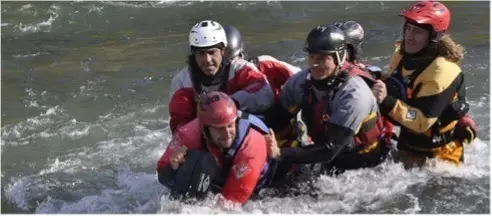
By Mark Hirst
At some point in our raft guiding careers we will all experience a flip! This article aims to highlight some of the key points associated with flipping and will hopefully deliver a few tips to aid in the recovery of a flipped raft along with its crew. Let’s focus on the 3 main areas of a flip:
- Before
- During
- After
BEFORE
One of the subjects often neglected during a safety demonstration is the flip. Raft guides often brush over the subject and only offer a few verbal pieces of information with no visual demonstration. This in turn can lead to a messy clean up as the crew did not receive enough information on what to do during a flip scenario.

Tip 1: Rig to flip
For those operating on rivers where there is a high chance of flipping you should prepare your customers with the “when we flip mentality” and not the “if we flip mentality”. Your safety demonstration should be focused on a flip recovery with visual demonstrations of the following points:
- Aggressive and defensive swimming.
- Swimming out from underneath an up turned raft, and the air pocket.
- Staying close to the raft.
- How the guide will re flip the raft.
- The job of the crew to aid in the recovery. When and where to hold on and when to let go of the raft.
- How to sit and paddle on an upturned raft.
- The guide’s main priority during the flip is to get on top of the up turned raft in order to assess the situation.
Tip 2: Before you drop in … prevention is better than cure
Before you enter a section of river or rapids where you know a flip is likely to occur, eddy out if possible and take a moment to re-brief your crew on what to do during a flip. Of course, prevention is better than cure by telling the crew what to expect in the rapid and what you want them to do. It is wise to also refresh the key points of your safety demonstration and remind them to be active in their own rescue. A quick PPE check should also be made in-case any PFDs or helmet straps have become loose.
I have also worked on rivers where the guide will flip the raft with the crew on the flat water before a rapid section in order to train the crew in what to do. By doing this the crew get to experience a flip in a controlled environment to help them prepare for the real thing further downstream.
An example of my re-cap is:
“During this rapid there is a high chance we will flip, or someone may fall out. Please remember these 3 points:
- If you fall out, smile, hold your paddle, do not stand up, swim back to the raft.
- If you cannot get back to the raft, smile, hold your paddle, do not stand up, adapt the WW swimming position.
- If the raft flips, smile, hold your paddle, do not stand up, stay close to the raft.”
I instruct all of my crew to smile as this reduces the risk of the crew panicking.

DURING
During a flip as a guide I have 3 main priorities.
- My own personal safety
- The safety of my crew
- The recovery of the raft
Tip 3: Get on top
During the initial stages of a flip the goal of the guide is to get back on top of the upturned raft as soon as possible. This is for 2 main reasons.
- It promotes guide safety as the guide is out of the water and this reduces entrapment and drowning risks.
- It allows the guide to make a headcount and assess the situation.
Tip 4: The head count
Locating your crew during a flip is a must. We are always taught that the guide of the flip needs to make a headcount which is true. A professional, well drilled team of guides and safety kayakers should also be working as a team to support the flipped raft in a number of ways:
- Set a safety perimeter so that no swimmers are left behind and all are recovered as quickly as possible
- Make their own head count to speed up the recovery process and communicate this to the guide.
Tip 5: We all know where the missing person is – right?
Nine times out of ten somebody always ends up panicking underneath the raft. Contrary to popular belief the guide should not actually jump back into the water and pull the customer out. By doing this the guide is exposing themselves to more risk. By simply re-flipping the raft as quickly as possible you are reducing the time the panicked swimmer spends under the raft.
Tip 6: To reflip or not to reflip?
In days gone by guides were taught to re-flip as soon as possible. The guide must use their judgement and knowledge of the river to make a decision to either re-flip or pull the crew onto the up turned raft and have them paddle it to an eddy where a re-flip can take place. On a shallow rocky technical river re-flipping mid rapid could potentially expose the guide and crew to injury from hitting rocks. So it would be a better option to pull the crew onto the up-turned raft. On a big volume, deep river where there is no risk of hitting any rocks, the guide may choose to re-flip the raft.

AFTER
If you have acted as a professional guide and correctly briefed your crew at the top of the rapids all that should be left to do is to give high-fives all around and to congratulate your crew on a job well-done. Checking in that all of your crew are okay physically is a good idea too.
If you did not prepare your crew correctly you now have some confidence re-building to do. Once you have everybody back inside the raft explain that flipping is a part of rafting. If the crew reacted badly to the flip and did not follow you instructions now would be a good time to explain what you need them to do should you flip again.
Post trip
A quick post trip de-brief by the trip leader can help to re-motivate a guide, and discuss any operational issues that occurred during the flip.
Any professionally run company will record any flips in the post trip paperwork. This is a good practice for the following reasons:
- Identification of flipping black-spots at certain river levels.
- Identify the training needs of the guide team.
- A set of notes in case of any arising complaints or legal claims: “No notes is no defense”.
SUMMARY
Prevention is better than cure and communication is key. By simply preparing your crew before the trip by communicating what to do during a flip will save you a lot of hassle. Flips need not be a bad experience. I have often had crews who have climbed back in the boat after a flip with massive smiles commenting on how fun the experience of flipping is if managed correctly.
My final top tips are:
- As a guide – smile throughout the flip process – this will help to relax your customers.
- If you have problems re-flipping a raft – work on your recovery technique until it is perfect. You will never be 100% confident as a guide if you know deep down that you cannot recover your raft after a flip.
- If you choose to rig your raft with lines and straps to assist you in recovery make sure that they do not become an entrapment hazard.
Have fun!
#AreYouReady #RaftersAreAwesome #guide #raft #rafting #raftguide #whitewater #fliptastic #StrongerTogether #internationalrafting #RiverFamily #WeAreIRF




